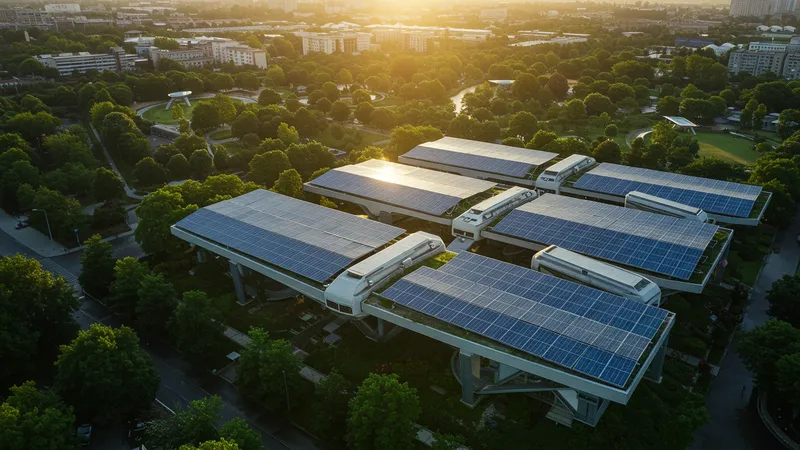


The sun is now powering more than just your morning. Solar energy technology has a secret that's quietly transforming its output efficiency—and it could change everything you thought you knew about green energy.
In today's rapidly shifting energy landscape, harnessing the full potential of solar power is not just an option—it's a necessity. Advanced tracking and software solutions now make this more achievable than ever. But there's a hidden breakthrough waiting to be revealed...

Picture this: solar panels shifting minutely by the hour, following the sun with pinpoint precision. This method alone can boost energy capture significantly. But here’s the kicker—traditional flat panels miss out on this everyday solar dance. How is it possible that we’ve just scratched the surface of solar potential? The secret lies in the technology that intertwines hardware with cutting-edge software, optimizing alignments, and adjusting angles to maximize sun exposure.
Yet, the real shock comes from the software analytics that accompany these tracking systems. Imagine a system that not only tracks but predicts shifts in weather patterns and adjusts the solar arrays in advance—capitalizing on every sunbeam while simultaneously minimizing shadow loss. You might think that’s the peak of innovation, but that’s not even the wildest part…
So, if you're intrigued by these advancements, hold on. The algorithms involved aren't just optimizing; they're evolving with machine learning capabilities that get smarter and more efficient with every sunny day. What happens next shocked even the experts...
The concept of solar tracking has taken the solar industry by storm. Fixed panels are a thing of the past in installations that aim for maximum efficiency. With trackers, panels move delicately in harmony with the sun's trajectory. Statistics reveal tracked array systems increase efficiency by 25%, a shift that lends a staggering advantage to renewable energy enthusiasts.

These systems use single or dual-axis trackers, which not only follow the east-to-west path but also adjust their tilt throughout the seasons. This game-changing approach is largely due to smart software integrating with the trackers. But there’s one more twist—these systems can even withstand adverse weather by self-correcting to minimize damage from strong winds or heavy snow loads.
One might think the upfront investment is prohibitive, but the long-term savings and increased energy output make it appealing. The return on investment can be realized in just a few short years, and that's not all. Stay tuned to uncover how this technology made a surprising breakthrough during unforeseen circumstances.
What you read next might change how you see solar innovations forever.
The backbone of this solar evolution is, surprisingly, the software running the whole operation. This software doesn't just control the physical hardware; it monitors, analyses, and optimizes at a granular level. Key metrics like solar intensity, angle optimization, and grid demands are seamlessly managed through a well-integrated system.

Machine learning algorithms are no longer futuristic jargon; they are the reality of software solutions like EnergoMax. Over time, these systems learn the optimal performance settings unique to each installation site. Users have reported up to a 40% increase in efficiency over systems running traditional controls. But here’s the groundbreaking insight—these systems can even anticipate failures before they occur.
This predictive capability reduces downtime and ensures maximal operational efficiency is maintained around the clock. Just when you thought this was the pinnacle of solar tech, there’s more. Find out how these software solutions are revolutionizing energy platforms worldwide.
Prepare to be dazzled by what's coming next.
Investing in solar tracking and software systems often triggers one major question—how does the cost weigh against the benefits? Surprisingly, the math may be more favorable than you think. Compared to conventional setups, the upfront cost might include an additional 20% due to advanced hardware and software.

However, data reveals that these systems achieve energy payback in half the time, making them more economical in the long run. On top of that, they provide a fail-safe against volatile energy prices by maximizing self-consumption of generated power. There’s an insider tip hidden amid all these calculations that savvy investors have been capitalizing on.
What you’ll read next could alter the financial reality for solar adopters significantly.
Discover the hidden benefits most industry insiders keep under wraps.
It’s not merely about efficiency or cost savings—these advances bear considerable significance for environmental protection. With increased energy capture capabilities, fewer panels are needed for larger outputs, which in turn reduces the demand for raw materials.

The reduction in physical resources contributes to a decrease in environmental disruption. It’s like we're seeing not just an energy revolution, but a full-scale eco-friendly movement where technology and nature coincide.
But that’s just scratching the surface. How do these systems integrate seamlessly with existing infrastructure and what are the environmental savings from that?
What you’ll uncover next shows how deep the green impact really goes.
Do these systems really work as advertised in the real world? Case studies suggest they do. Take, for example, the Sunshine City initiative, which transformed an entire neighborhood by employing solar trackers and advanced software. Results? A jaw-dropping 60% increase in energy efficiency collectively for all homes.

Such tailored systems work wonders for commercial entities too, reducing operational costs while elevating sustainability goals. Companies like E-Tech Solutions have reported an impressive reduction in energy expenses by optimizing solar usage. Yet, the real magic unfolds when these systems surpass theoretical efficiency benchmarks, setting new records.
It’s no longer a question of if but when will solar be a mainstream energy source across the globe. But the tale doesn't end here. There’s an unexpected development that even the skeptics find astonishing.
Stay tuned, as the final pages reveal everything.
One might wonder, are there roadblocks standing in the way of widespread adoption? It turns out, regulations play a double role. Initially perceived as barriers due to stringent requirements, they also emerged as growth boosters by setting standards and incentives that push the industry forward.

Tax credits, subsidies, and feed-in tariffs are just a few regulatory boosts promoting the shift to solar. The power of legislative support has unlocked unprecedented potential. But the real surprise comes from unexpected policy shifts in major economies like the US and China.
These strategic changes have provided a fertile ground for solar adoption to flourish. The intricacies within these regulatory frameworks hold key insights that are bound to enlighten and empower future solar adopters.
Get ready for a standout revelation on how policy is reshaping the solar landscape worldwide.
Every technological advancement faces challenges, and solar trackers with smart software are no exception. Integration with existing infrastructure can pose hurdles, but modern solutions have evolved to address these with minimal disruption.

Retrofitting these systems is becoming increasingly streamlined, as seen in projects that link modern tracking devices with older assemblies successfully. Flexibility in consumer applications has led the vanguard for seamless z transitions—transforming uncertainty into opportunity.
So how are industry leaders tackling these intricate challenges? Their bets on innovation have paid off handsomely, proving skeptics wrong.
Find out the strategic maneuvers that have placed them at the forefront, leading the way for all solar revolutions.
As we marvel at current advancements, the question looms large—what does the future hold? Researchers are tirelessly working on breakthrough concepts like organic solar cells and solar paint. These innovations might eventually redefine outer boundaries once thought impossible.

And then there’s the bold attempt to capitalize on space-based solar harvesting, a futuristic approach looking to transmit solar energy directly from space to earth, sidestepping atmospheric reduction.
It sounds like science fiction, but preliminary tests are already showing promise. The intersection of imagination and innovation is likely to carve out the next era of optimized energy capture.
Stay hooked as you read on—discover the blueprints for future solar conquests that will redefine how human civilization harnesses the sun’s unyielding power.
The solar industry is not only about the technology but about who innovates faster and better. Industrial giants are racing against time, leveraging proprietary technologies and exclusive partnerships to outpace their competition.

What unites these leaders is a commitment to driving the industry forward, focusing on research and development enhanced by strategic collaborations. Companies excelling in this space are reaping substantial rewards.
Case in point—industry leader Solaris skyrocketed its market share through savvy acquisitions and cutting-edge product launches faster than their rivals. Now let’s get to the heart of it—how can emerging players tap into this momentum to transform their solar dreams into reality?
Your backstage pass awaits! The untold secrets of industry frontrunners reveal themselves.
Trendy tech aside, the real story unfolds in market dynamics shaping solar’s future. Demand for sustainable power has grown exponentially, pushing boundaries and suggesting the market has yet to reach its full potential.

One fascinating trend is the rapid democratization of solar technology, putting advanced tools into the hands of consumers globally. And it appears this shift is leading toward a more sustainable global energy landscape, propelled by savvy investors and conscious consumers alike.
Predictive analytics hint at a burgeoning trend that could shift energy paradigms as we know them. Intrigued yet? What lies beyond could redefine those market projections altogether.
Follow through—this storyline concludes with an eye-opening finale on upcoming market transformations.
As we wrap up our exploration of the latest in solar innovations, it’s clear that the sun is shining its brightest in the world of energy solutions. The convergence of technology, market growth, and legal frameworks promises a sustainable future where solar isn’t just viable—it’s vital.

The only question remaining: how quickly will you be part of this energy evolution? Now you’ve got the insights, the power shift is yours to embrace. Share the knowledge, ignite conversations, and step into the future—solar power awaits!